Seasonal Precipitation and Anomaly Analysis in Middle East Asian Countries Using Google Earth Engine
Abstract
1. Introduction
2. Materials and Methods
2.1. Study Area
2.2. Data Collection and Quality
2.3. Rainfall Variation Analysis
2.4. Rainfall Anomaly Variation Analysis
2.5. Rainfall Forecast Using ARIMA and ETS
2.6. Error Matrix Analysis
3. Results and Discussion
3.1. Rainfall Variation Analysis
3.2. Rainfall Anomaly Variation Analysis
3.3. Rainfall Forecast Using the ARIMA and ETS Models
4. Discussion
- Projects for Water Resource Management: To cut down on water wastage, countries like Saudi Arabia, the United Arab Emirates, and Jordan have made significant investments in desalination facilities, water recycling systems, and cutting-edge irrigation system technology [68].
- National Climate Change Strategies: Certain goals for cutting carbon emissions, advancing renewable energy, and improving water sustainability are included in Saudi Arabia’s Vision 2030 and the United Arab Emirates’ National Climate Change Plan.
- International Cooperation: To obtain funds and technical support for climate resilience initiatives, numerous Middle Eastern countries take part in international accords, including the Paris Agreement, and work with international organizations.
- Early Warning Systems: For extreme weather occurrences like flash floods and droughts, early warning systems have been enhanced by investments in hydrological and meteorological monitoring systems.
5. Limitations and Future Research Direction
6. Conclusions
Author Contributions
Funding
Data Availability Statement
Acknowledgments
Conflicts of Interest
References
- Panda, K.C.; Singh, R.M.; Singh, V.K.; Singla, S.; Paramaguru, P.K. Impact of Climate Change Induced Future Rainfall Variation on Dynamics of Arid-Humid Zone Transition in the Western Province of India. J. Environ. Manag. 2023, 325, 116646. [Google Scholar] [CrossRef] [PubMed]
- Moazzam, M.F.U.; Rahman, G.; Munawar, S.; Farid, N.; Lee, B.G. Spatiotemporal Rainfall Variability and Drought Assessment during Past Five Decades in South Korea Using SPI and SPEI. Atmosphere 2022, 13, 292. [Google Scholar] [CrossRef]
- Mokhtar, M.B.; Ahmed, M.F. Managing a Road as a River to Mitigate the Impact of Urban Flash Floods. J. Flood Risk Manag. 2022, 15, 1. [Google Scholar] [CrossRef]
- Al Mahasneh, L.; Abuhamoor, D.; Al Sane, K.; Aldashti, H.; Haddad, N. Mapping the Potential Flood Frequency Zones in Jordan Using Gumbel Distribution and GIS. DYSONA-Appl. Sci. 2025, 6, 343–350. [Google Scholar]
- Xu, M.; Bravo de Guenni, L.; Córdova, J.R. Climate Change Impacts on Rainfall Intensity-Duration-Frequency Curves in Local Scale Catchments. Environ. Monit. Assess. 2024, 196, 372. [Google Scholar] [CrossRef]
- Mishra, A.K.; Dinesh, A.S.; Kumari, A.; Pandey, L.K. Precipitation Extremes over India in a Coupled Land–Atmosphere Regional Climate Model: Influence of the Land Surface Model and Domain Extent. Atmosphere 2024, 15, 44. [Google Scholar] [CrossRef]
- Al-Sheriadeh, M.; Al-Sharman, A.R. Evaluation of Satellite Rainfall Estimates Using PERSIANN-CDR and TRMM over Three Critical Cells in Jordan. J. Hydroinform. 2024, 26, 424–440. [Google Scholar] [CrossRef]
- Funk, C.; Peterson, P.; Landsfeld, M.; Pedreros, D.; Verdin, J.; Shukla, S.; Husak, G.; Rowland, J.; Harrison, L.; Hoell, A. The Climate Hazards Infrared Precipitation with Stations—A New Environmental Record for Monitoring Extremes. Sci. Data 2015, 2, 150066. [Google Scholar] [CrossRef]
- Lenka, S.; Devi, R.; Joseph, C.M.; Gouda, K.C. Effect of Large-Scale Oceanic and Atmospheric Processes on the Indian Summer Monsoon. Theor. Appl. Climatol. 2022, 147, 1561–1576. [Google Scholar] [CrossRef]
- Jin, Q.; Wei, J.; Yang, Z.-L.; Pu, B.; Huang, J. Consistent Response of Indian Summer Monsoon to Middle East Dust in Observations and Simulations. Atmos. Chem. Phys. 2015, 15, 9897–9915. [Google Scholar] [CrossRef]
- Nicholson, S.E. Climate of the Sahel and West Africa. In Oxford Research Encyclopedia of Climate Science; Oxford University Press: Oxford, UK, 2018. [Google Scholar]
- Taschetto, A.S.; Ummenhofer, C.C.; Stuecker, M.F.; Dommenget, D.; Ashok, K.; Rodrigues, R.R.; Yeh, S. ENSO Atmospheric Teleconnections. In El Niño Southern Oscillation in a Changing Climate; AGU Publications: Washington, DC, USA, 2020; pp. 309–335. [Google Scholar]
- Almazroui, M. The Influence of the Madden–Julian Oscillation on the Wet Season Rainfall over Saudi Arabia. Earth Syst. Environ. 2023, 7, 1–14. [Google Scholar] [CrossRef]
- Faraji, M.; Borsato, A.; Frisia, S.; Hartland, A.; Hellstrom, J.C.; Greig, A. High-Resolution Reconstruction of Infiltration in the Southern Cook Islands Based on Trace Elements in Speleothems. Quat. Res. 2024, 118, 20–40. [Google Scholar] [CrossRef]
- Founda, D.; Giannakopoulos, C. The Exceptionally Hot Summer of 2007 in Athens, Greece—A Typical Summer in the Future Climate? Glob. Planet. Change 2009, 67, 227–236. [Google Scholar] [CrossRef]
- de Vries, A.J.; Tyrlis, E.; Edry, D.; Krichak, S.O.; Steil, B.; Lelieveld, J. Extreme Precipitation Events in the Middle East: Dynamics of the Active Red Sea Trough. J. Geophys. Res. Atmos. 2013, 118, 7087–7108. [Google Scholar] [CrossRef]
- Francis, D.; Alshamsi, N.; Cuesta, J.; Gokcen Isik, A.; Dundar, C. Cyclogenesis and Density Currents in the Middle East and the Associated Dust Activity in September 2015. Geosciences 2019, 9, 376. [Google Scholar] [CrossRef]
- Francis, D.; Eayrs, C.; Chaboureau, J.; Mote, T.; Holland, D.M. Polar Jet Associated Circulation Triggered a Saharan Cyclone and Derived the Poleward Transport of the African Dust Generated by the Cyclone. J. Geophys. Res. Atmos. 2018, 123, 11–899. [Google Scholar] [CrossRef]
- Liu, J.; Wu, D.; Xu, X.; Ji, M.; Chen, Q.; Wang, X. Projection of Extreme Precipitation Induced by Arctic Amplification over the Northern Hemisphere. Environ. Res. Lett. 2021, 16, 74012. [Google Scholar] [CrossRef]
- Toté, C.; Patricio, D.; Boogaard, H.; Van Der Wijngaart, R.; Tarnavsky, E.; Funk, C. Evaluation of Satellite Rainfall Estimates for Drought and Flood Monitoring in Mozambique. Remote Sens. 2015, 7, 1758–1776. [Google Scholar] [CrossRef]
- Lüning, S.; Vahrenholt, F. Holocene Climate Development of North Africa and the Arabian Peninsula. In The Geology of the Arab World—An Overview; Springer International Publishing: Cham, Switzerland, 2019; pp. 507–546. [Google Scholar]
- Charpentier, V.; Méry, S. A Neolithic Settlement near the Strait of Hormuz: Akab Island, United Arab Emirates. Proc. Semin. Arab. Stud. 2008, 38, 117–136. [Google Scholar]
- Elnashar, A.; Zeng, H.; Wu, B.; Zhang, N.; Tian, F.; Zhang, M.; Zhu, W.; Yan, N.; Chen, Z.; Sun, Z. Downscaling TRMM Monthly Precipitation Using Google Earth Engine and Google Cloud Computing. Remote Sens. 2020, 12, 3860. [Google Scholar] [CrossRef]
- Hochman, A.; Shachar, N.; Gildor, H. Unraveling Sub-Seasonal Precipitation Variability in the Middle East via Indian Ocean Sea Surface Temperature. Sci. Rep. 2024, 14, 2919. [Google Scholar] [CrossRef]
- Massoud, E.; Massoud, T.; Guan, B.; Sengupta, A.; Espinoza, V.; De Luna, M.; Raymond, C.; Waliser, D. Atmospheric Rivers and Precipitation in the Middle East and North Africa (MENA). Water 2020, 12, 2863. [Google Scholar] [CrossRef]
- Nguyen, P.; Shearer, E.J.; Tran, H.; Ombadi, M.; Hayatbini, N.; Palacios, T.; Huynh, P.; Braithwaite, D.; Updegraff, G.; Hsu, K. The CHRS Data Portal, an Easily Accessible Public Repository for PERSIANN Global Satellite Precipitation Data. Sci. Data 2019, 6, 180296. [Google Scholar] [CrossRef] [PubMed]
- Nguyen, P.; Ombadi, M.; Gorooh, V.A.; Shearer, E.J.; Sadeghi, M.; Sorooshian, S.; Hsu, K.; Bolvin, D.; Ralph, M.F. Persiann Dynamic Infrared–Rain Rate (PDIR-Now): A near-Real-Time, Quasi-Global Satellite Precipitation Dataset. J. Hydrometeorol. 2020, 21, 2893–2906. [Google Scholar] [CrossRef] [PubMed]
- Hsu, K.L.; Gao, X.; Sorooshian, S.; Gupta, H.V. Precipitation estimation from remotely sensed information using artificial neural networks. J. Appl. Meteorol. 1997, 36, 1176–1190. [Google Scholar] [CrossRef]
- Pham, Q.B.; Abba, S.I.; Usman, A.G.; Linh, N.T.T.; Gupta, V.; Malik, A.; Costache, R.; Vo, N.D.; Tri, D.Q. Potential of Hybrid Data-Intelligence Algorithms for Multi-Station Modelling of Rainfall. Water Resour. Manag. 2019, 33, 5067–5087. [Google Scholar] [CrossRef]
- Shi, Y. Forecasting Mortality Rates with the Penalized Exponential Smoothing State Space Model. J. Oper. Res. Soc. 2022, 73, 955–968. [Google Scholar] [CrossRef]
- Al-Bakri, J.T.; Suleiman, A.S. NDVI Response to Rainfall in Different Ecological Zones in Jordan. Int. J. Remote Sens. 2004, 25, 3897–3912. [Google Scholar] [CrossRef]
- P Sabin, T.; Krishnan, R.; Ghattas, J.; Denvil, S.; Dufresne, J.-L.; Hourdin, F.; Pascal, T. High Resolution Simulation of the South Asian Monsoon Using a Variable Resolution Global Climate Model. Clim. Dyn. 2013, 41, 173–194. [Google Scholar] [CrossRef]
- Özdemir, S.; Özkan, K.; Mert, A. An Ecological Perspective on Climate Change Scenarios. Biol. Divers. Conserv. 2020, 13, 361–371. [Google Scholar] [CrossRef]
- Adloff, F.; Somot, S.; Sevault, F.; Jordà, G.; Aznar, R.; Déqué, M.; Herrmann, M.; Marcos, M.; Dubois, C.; Padorno, E. Mediterranean Sea Response to Climate Change in an Ensemble of Twenty First Century Scenarios. Clim. Dyn. 2015, 45, 2775–2802. [Google Scholar] [CrossRef]
- Lelieveld, J.; Proestos, Y.; Hadjinicolaou, P.; Tanarhte, M.; Tyrlis, E.; Zittis, G. Strongly Increasing Heat Extremes in the Middle East and North Africa (MENA) in the 21st Century. Clim. Change 2016, 137, 245–260. [Google Scholar] [CrossRef]
- Le, A.M.; Pricope, N.G. Increasing the Accuracy of Runoff and Streamflow Simulation in the Nzoia Basin, Western Kenya, through the Incorporation of Satellite-Derived CHIRPS Data. Water 2017, 9, 114. [Google Scholar] [CrossRef]
- Funk, C.; Verdin, A.; Michaelsen, J.; Peterson, P.; Pedreros, D.; Husak, G. A Global Satellite-Assisted Precipitation Climatology. Earth Syst. Sci. Data 2015, 7, 275–287. [Google Scholar] [CrossRef]
- Aldughairi, A.A. Climate Change Assessment in Middle and Northern Saudi Arabia: Alarming Trends. DYSONA-Appl. Sci. 2025, 6, 60–69. [Google Scholar]
- Ilori, O.W.; Ajayi, V.O. Change Detection and Trend Analysis of Future Temperature and Rainfall over West Africa. Earth Syst. Environ. 2020, 4, 493–512. [Google Scholar] [CrossRef]
- Vinoj, V.; Rasch, P.J.; Wang, H.; Yoon, J.-H.; Ma, P.-L.; Landu, K.; Singh, B. Short-Term Modulation of Indian Summer Monsoon Rainfall by West Asian Dust. Nat. Geosci. 2014, 7, 308–313. [Google Scholar] [CrossRef]
- Solmon, F.; Nair, V.S.; Mallet, M. Increasing Arabian Dust Activity and the Indian Summer Monsoon. Atmos. Chem. Phys. 2015, 15, 8051–8064. [Google Scholar] [CrossRef]
- Jin, Q.; Wei, J.; Lau, W.K.M.; Pu, B.; Wang, C. Interactions of Asian Mineral Dust with Indian Summer Monsoon: Recent Advances and Challenges. Earth-Sci. Rev. 2021, 215, 103562. [Google Scholar] [CrossRef]
- Abo-Monasar, A.; Al-Zahrani, M.A. Estimation of Rainfall Distribution for the Southwestern Region of Saudi Arabia. Hydrol. Sci. J. 2014, 59, 420–431. [Google Scholar] [CrossRef]
- World Bank Publications. Turn Down the Heat: Confronting the New Climate Normal; World Bank Publications: Washington, DC, USA, 2014; ISBN 1464804370. [Google Scholar]
- Ebrahim, M.F.; Meisner, C.M. Sustainable Land Management and Restoration in the Middle East and North Africa Region: Issues, Challenges, and Recommendations; World Bank Group: Washington, DC, USA, 2019. [Google Scholar]
- Pal, J.S.; Eltahir, E.A.B. Future Temperature in Southwest Asia Projected to Exceed a Threshold for Human Adaptability. Nat. Clim. Change 2016, 6, 197–200. [Google Scholar] [CrossRef]
- Brown, O.; Crawford, A. Climate Change and Security in Africa; International Institute for Sustainable Development: Winnipeg, MB, Canada, 2009. [Google Scholar]
- Sheppard, C.; Al-Husiani, M.; Al-Jamali, F.; Al-Yamani, F.; Baldwin, R.; Bishop, J.; Benzoni, F.; Dutrieux, E.; Dulvy, N.K.; Durvasula, S.R.V.; et al. The Gulf: A Young Sea in Decline. Mar. Pollut. Bull. 2010, 60, 13–38. [Google Scholar] [CrossRef] [PubMed]
- Bucchignani, E.; Mercogliano, P.; Rianna, G.; Panitz, H. Analysis of ERA-Interim-driven COSMO-CLM Simulations over Middle East–North Africa Domain at Different Spatial Resolutions. Int. J. Climatol. 2016, 36, 3346–3369. [Google Scholar] [CrossRef]
- Xue, P.; Eltahir, E.A.B. Estimation of the Heat and Water Budgets of the Persian (Arabian) Gulf Using a Regional Climate Model. J. Clim. 2015, 28, 5041–5062. [Google Scholar] [CrossRef]
- Almazroui, M.; Islam, M.N.; Jones, P.D.; Athar, H.; Rahman, M.A. Recent Climate Change in the Arabian Peninsula: Seasonal Rainfall and Temperature Climatology of Saudi Arabia for 1979–2009. Atmos. Res. 2012, 111, 29–45. [Google Scholar] [CrossRef]
- Evans, J.P. 21st Century Climate Change in the Middle East. Clim. Change 2009, 92, 417–432. [Google Scholar] [CrossRef]
- Nashwan, M.S.; Shahid, S.; Dewan, A.; Ismail, T.; Alias, N. Performance of Five High Resolution Satellite-Based Precipitation Products in Arid Region of Egypt: An Evaluation. Atmos. Res. 2020, 236, 104809. [Google Scholar] [CrossRef]
- Swetnam, T.W.; Lynch, A.M. Multicentury, Regional-scale Patterns of Western Spruce Budworm Outbreaks. Ecol. Monogr. 1993, 63, 399–424. [Google Scholar] [CrossRef]
- Nguyen, P.; Ombadi, M.; Sorooshian, S.; Hsu, K.; AghaKouchak, A.; Braithwaite, D.; Ashouri, H.; Thorstensen, A.R. The PERSIANN Family of Global Satellite Precipitation Data: A Review and Evaluation of Products. Hydrol. Earth Syst. Sci. 2018, 22, 5801–5816. [Google Scholar] [CrossRef]
- Moltz, J. The Politics of Space Security: Strategic Restraint and the Pursuit of National Interests; Stanford University Press: Redwood City, CA, USA, 2011; ISBN 0804778582. [Google Scholar]
- Waha, K.; Krummenauer, L.; Adams, S.; Aich, V.; Baarsch, F.; Coumou, D.; Fader, M.; Hoff, H.; Jobbins, G.; Marcus, R.; et al. Climate Change Impacts in the Middle East and Northern Africa (MENA) Region and Their Implications for Vulnerable Population Groups. Reg. Environ. Change 2017, 17, 1623–1638. [Google Scholar] [CrossRef]
- Musa, Z.N.; Popescu, I.; Mynett, A. A Review of Applications of Satellite SAR, Optical, Altimetry and DEM Data for Surface Water Modelling, Mapping and Parameter Estimation. Hydrol. Earth Syst. Sci. 2015, 19, 3755–3769. [Google Scholar] [CrossRef]
- Osborn, T.; Barichivich, J.; Harris, I.; van der Schrier, G.; Jones, P. Monitoring Global Drought Using the Self-Calibrating Palmer Drought Severity Index [in “State of the Climate in 2016”]. Bull. Am. Meteorol. Soc. 2017, 98, S32–S33. [Google Scholar]
- Namdari, S.; Karimi, N.; Sorooshian, A.; Mohammadi, G.; Sehatkashani, S. Impacts of Climate and Synoptic Fluctuations on Dust Storm Activity over the Middle East. Atmos. Environ. 2018, 173, 265–276. [Google Scholar] [CrossRef] [PubMed]
- Kantoush, S.A.; Saber, M.; Abdel-Fattah, M.; Sumi, T. Integrated Strategies for the Management of Wadi Flash Floods in the Middle East and North Africa (MENA) Arid Zones: The ISFF Project. In Wadi Flash Floods: Challenges and Advanced Approaches for Disaster Risk Reduction; Springer: Berlin/Heidelberg, Germany, 2022; pp. 3–34. [Google Scholar]
- Thakur, D.A.; Mohanty, M.P. Exploring the Fidelity of Satellite Precipitation Products in Capturing Flood Risks: A Novel Framework Incorporating Hazard and Vulnerability Dimensions over a Sensitive Coastal Multi-Hazard Catchment. Sci. Total Environ. 2024, 920, 170884. [Google Scholar] [CrossRef]
- Katiraie-Boroujerdy, P.-S.; Asanjan, A.A.; Hsu, K.; Sorooshian, S. Intercomparison of PERSIANN-CDR and TRMM-3B42V7 Precipitation Estimates at Monthly and Daily Time Scales. Atmos. Res. 2017, 193, 36–49. [Google Scholar] [CrossRef]
- Garreaud, R.D. Record-Breaking Climate Anomalies Lead to Severe Drought and Environmental Disruption in Western Patagonia in 2016. Clim. Res. 2018, 74, 217–229. [Google Scholar] [CrossRef]
- Levizzani, V.; Amorati, R.; Meneguzzo, F. A Review of Satellite-Based Rainfall Estimation Methods; Consiglio Nazionale delle Ricerche Istituto di Scienze dell’Atmosfera e del Clima: Bologna, Italy, 2002. [Google Scholar]
- Hanjra, M.A.; Qureshi, M.E. Global Water Crisis and Future Food Security in an Era of Climate Change. Food Policy 2010, 35, 365–377. [Google Scholar] [CrossRef]
- Paul, V.K.; Rastogi, A.; Dua, S.; Basu, C. Healthcare Infrastructure, Resilience and Climate Change: Preparing for Extreme Weather Events; Routledge: London, UK, 2023; ISBN 1003393101. [Google Scholar]
- Burt, J.A. Managing the Growing Impacts of Development on Fragile Coastal and Marine Systems: Lessons from the Gulf; UNU-INWEH: Hamilton, ON, Canada, 2011. [Google Scholar]
- Fayssal, F. Sustainable Water Management in Naturally Deforested Regions & Proportional Accreditation: UAE Case Study. Int. J. Environ. Eng. Dev. 2024, 2, 269–282. [Google Scholar]
- Ghanem, A.M.; Alamri, Y.A. The Impact of the Green Middle East Initiative on Sustainable Development in the Kingdom of Saudi Arabia. J. Saudi Soc. Agric. Sci. 2023, 22, 35–46. [Google Scholar] [CrossRef]
- Agarwal, P.K. Climate Change: Implications for Indian Agriculture. Jalvigyan Sameeksha 2007, 22, 37–46. [Google Scholar]
- Khedher, K.M.; Abu-Taweel, G.M.; Al-Fifi, Z.; Qoradi, M.D.; Al-Khafaji, Z.; Halder, B.; Bandyopadhyay, J.; Shahid, S.; Essaied, L.; Yaseen, Z.M. Farasan Island of Saudi Arabia Confronts the Measurable Impacts of Global Warming in 45 Years. Sci. Rep. 2022, 12, 14322. [Google Scholar] [CrossRef]
- Agha, H.M.; Alkamil, A.A.; Yahya, R.T.; Mohammed, A.A.; Ali, Z.T.; Alsayadi, M.M.S. Consequences of Global Climate Change on Biodiversity and Food Security: A Mini Review. AUIQ Complement. Biol. Syst. 2024, 1, 43–51. [Google Scholar] [CrossRef]
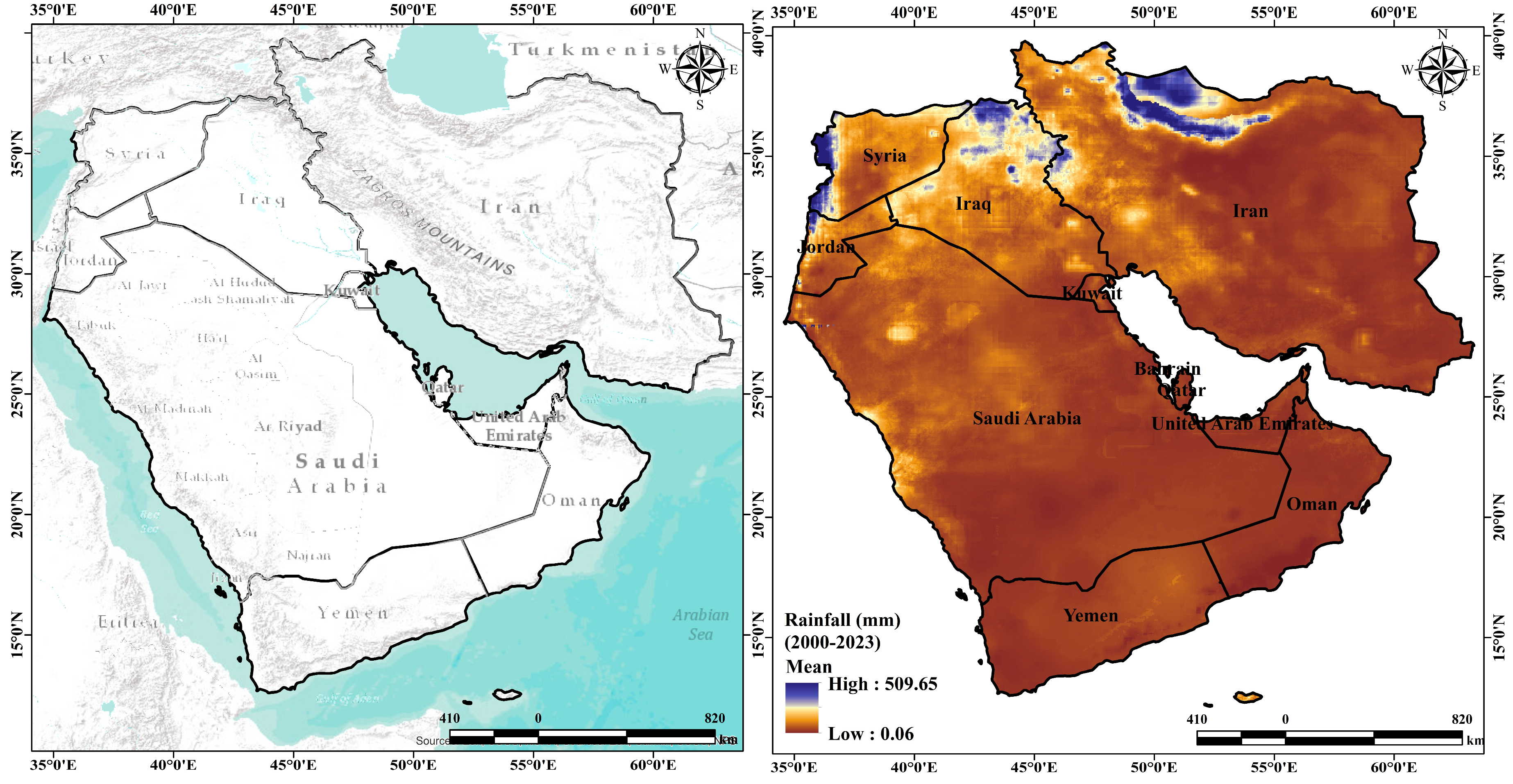
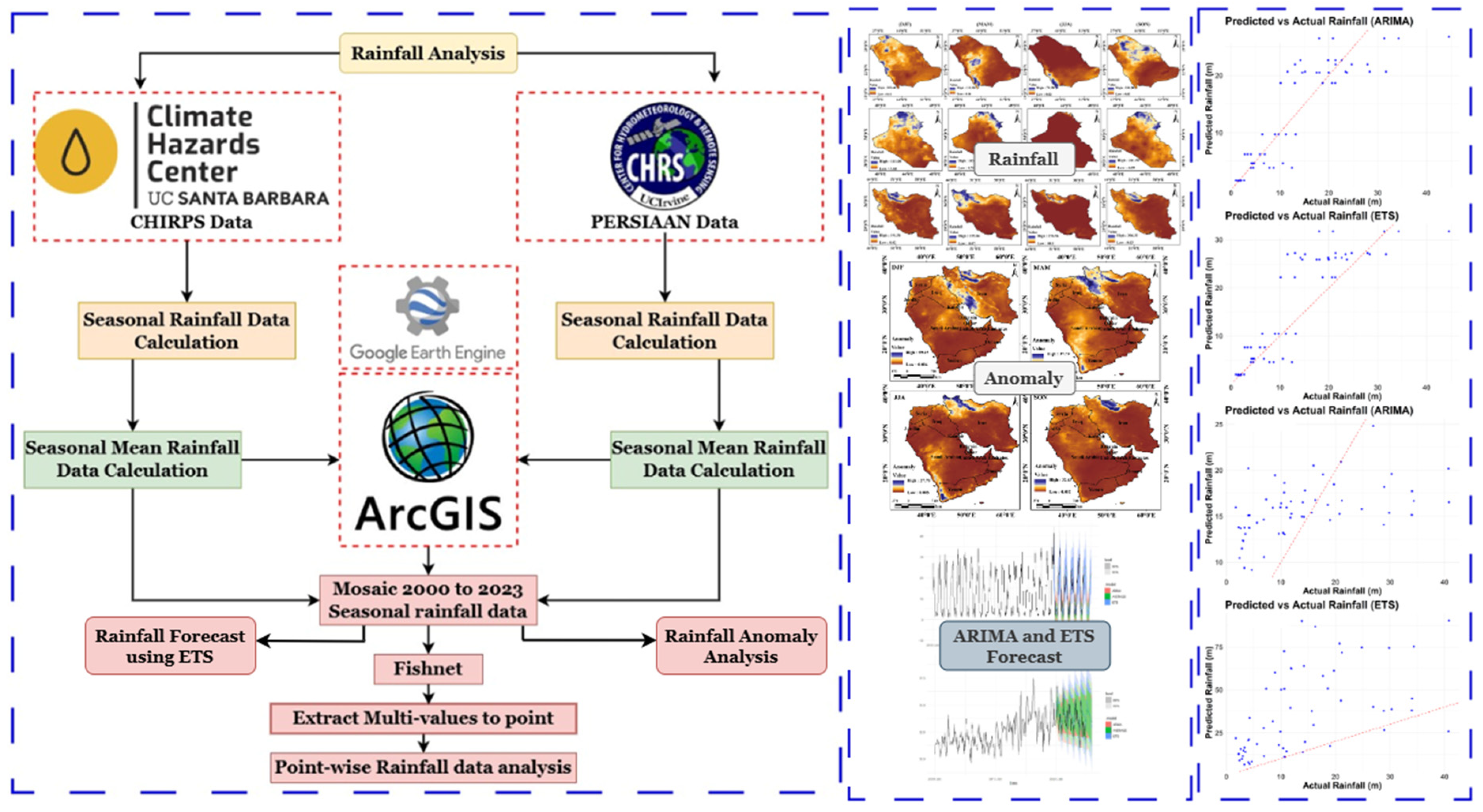

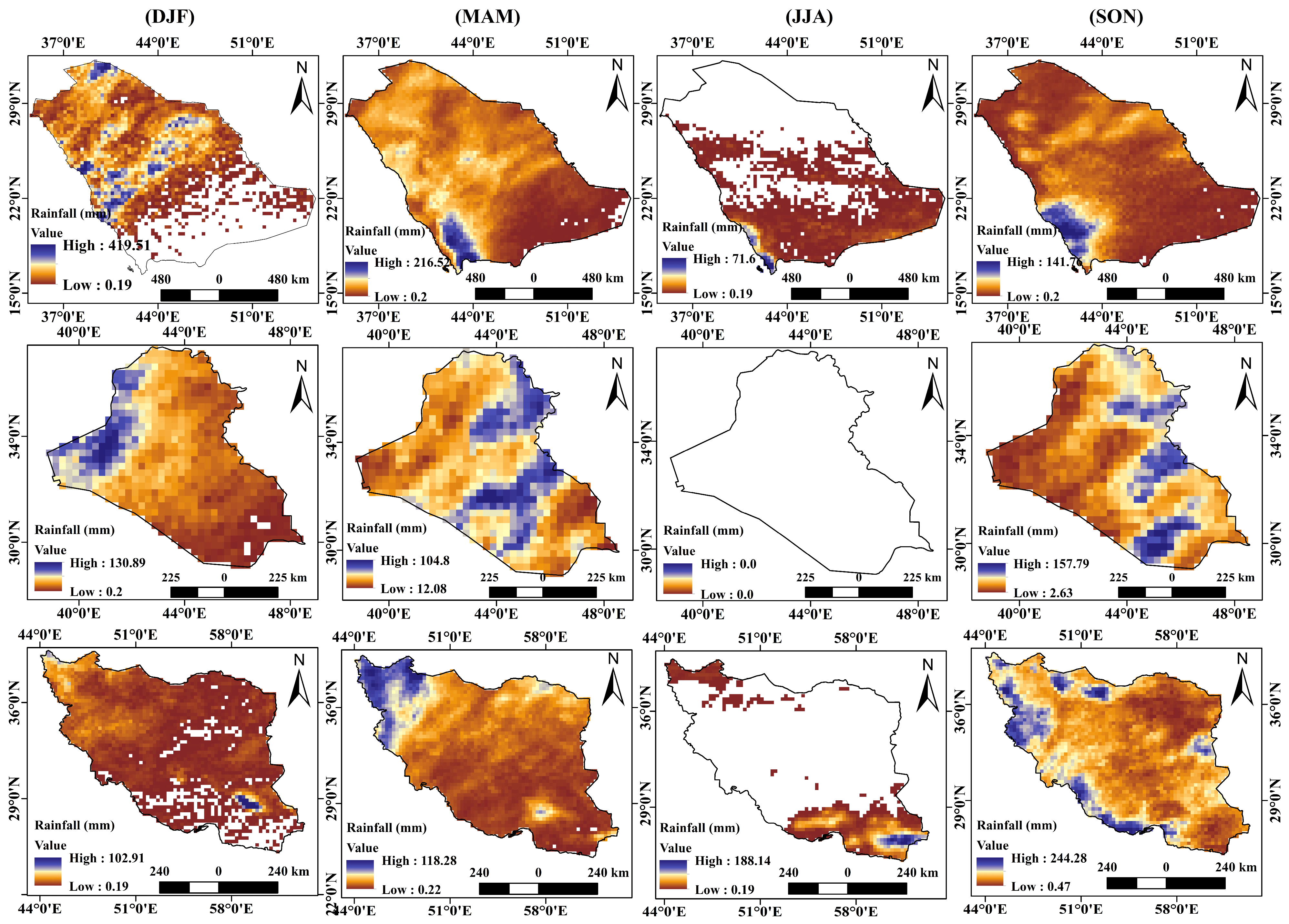

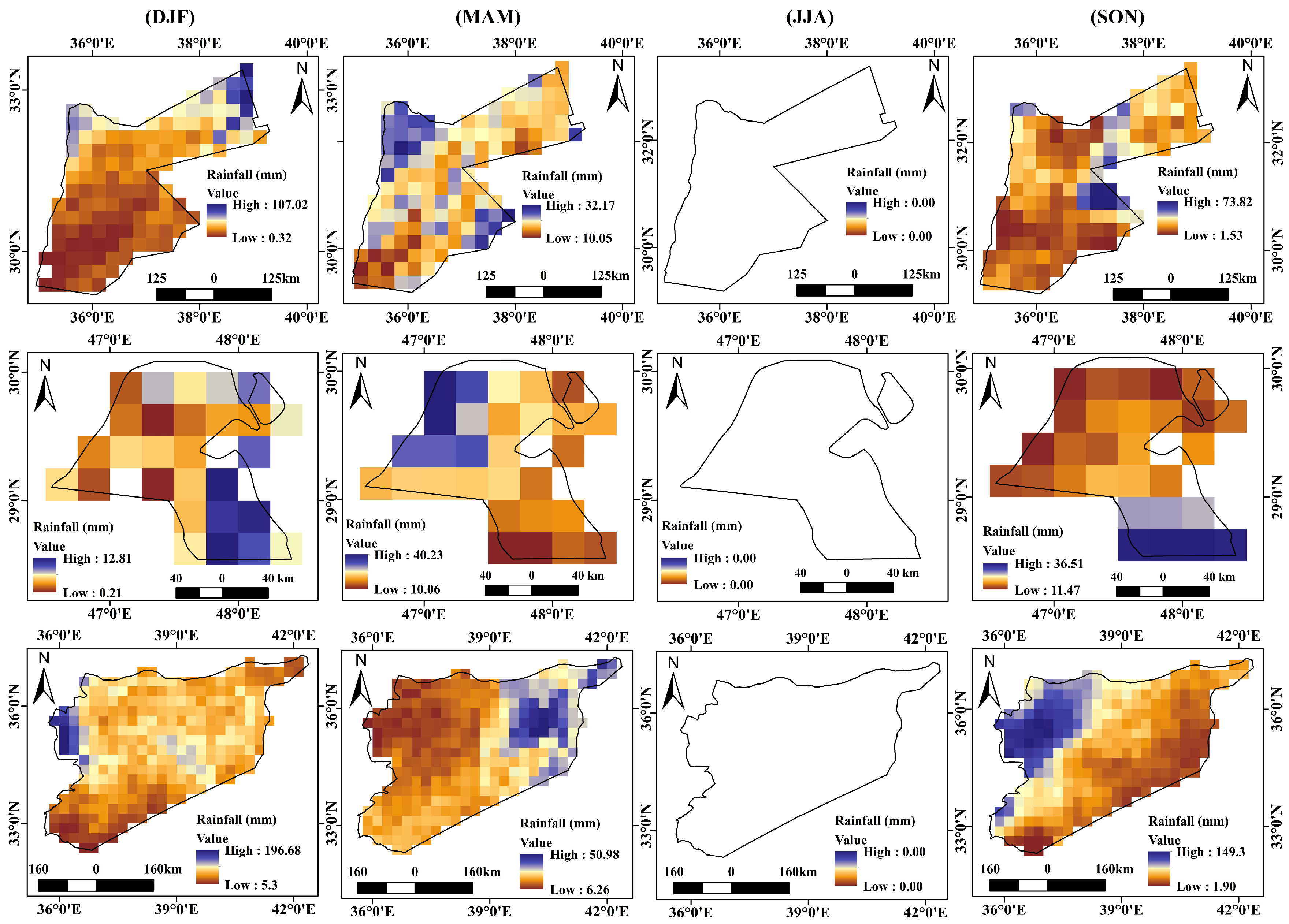
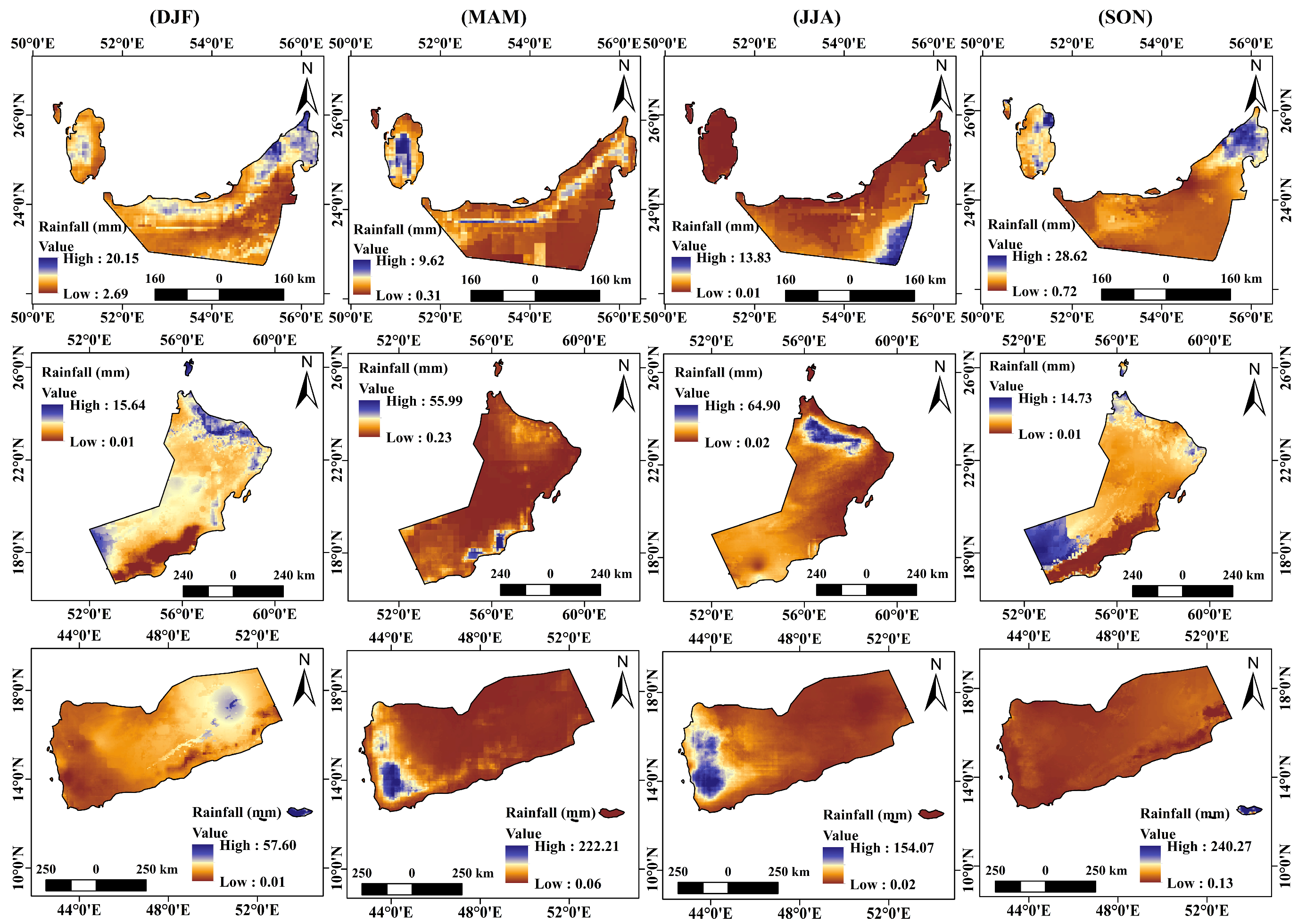

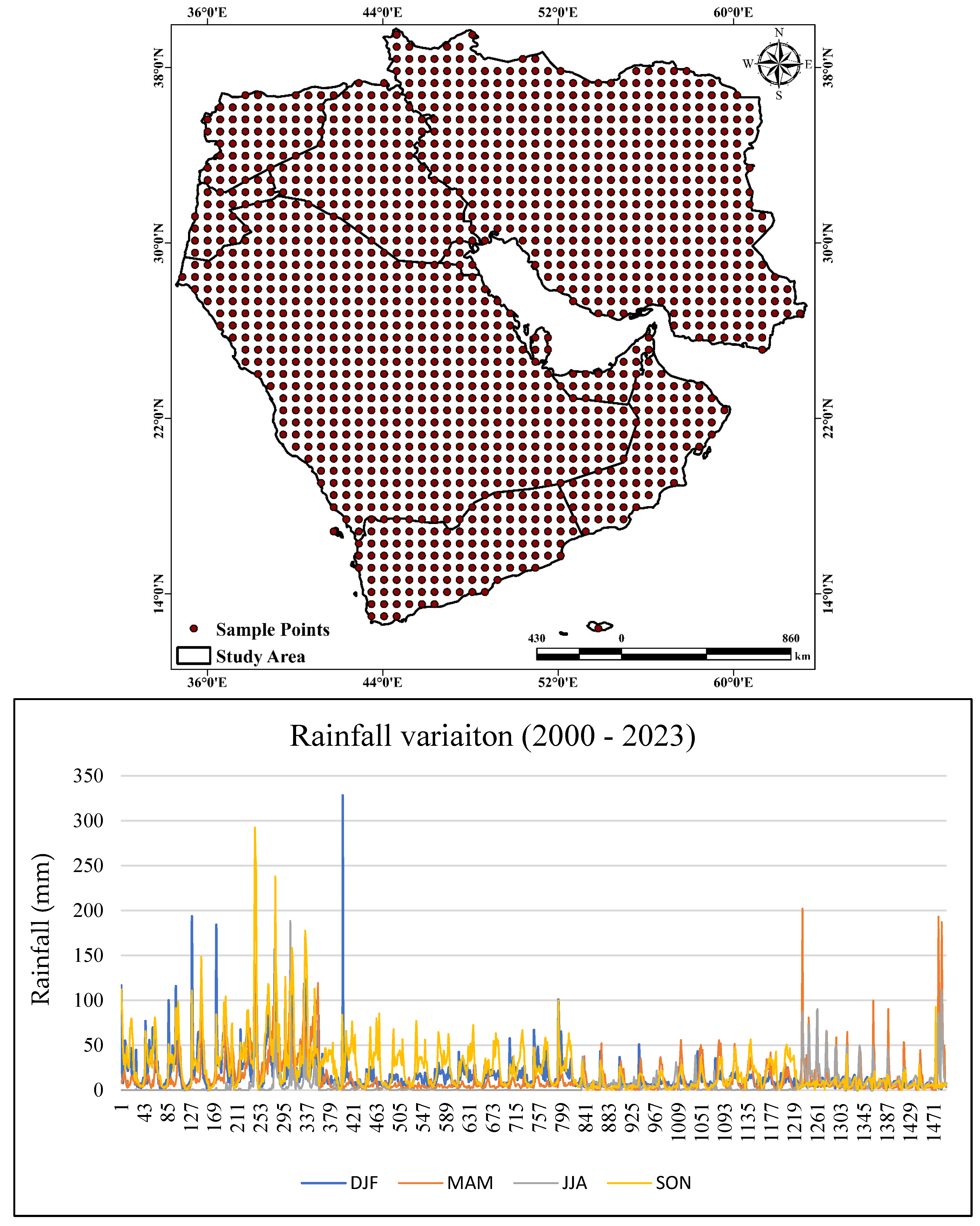

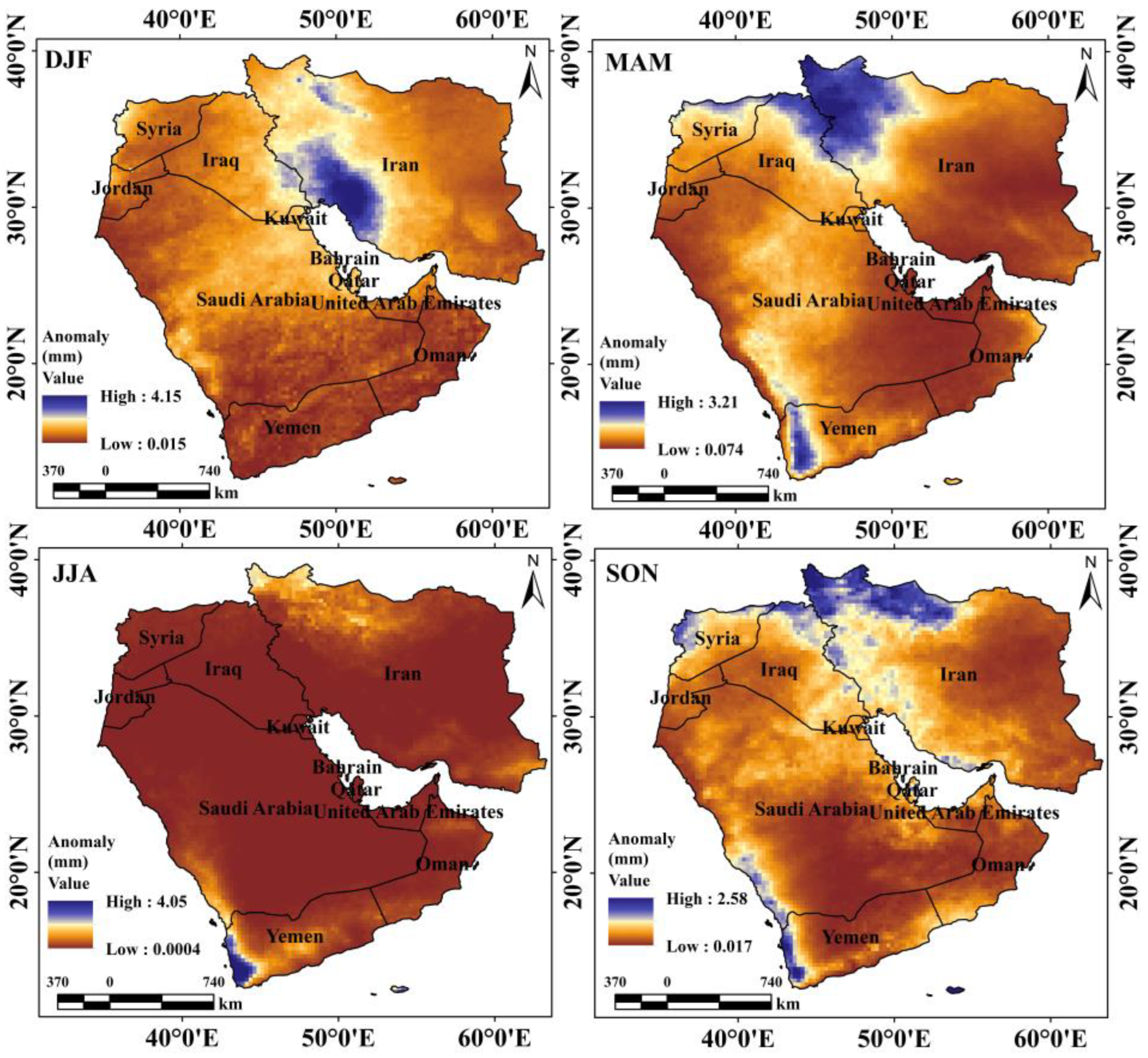


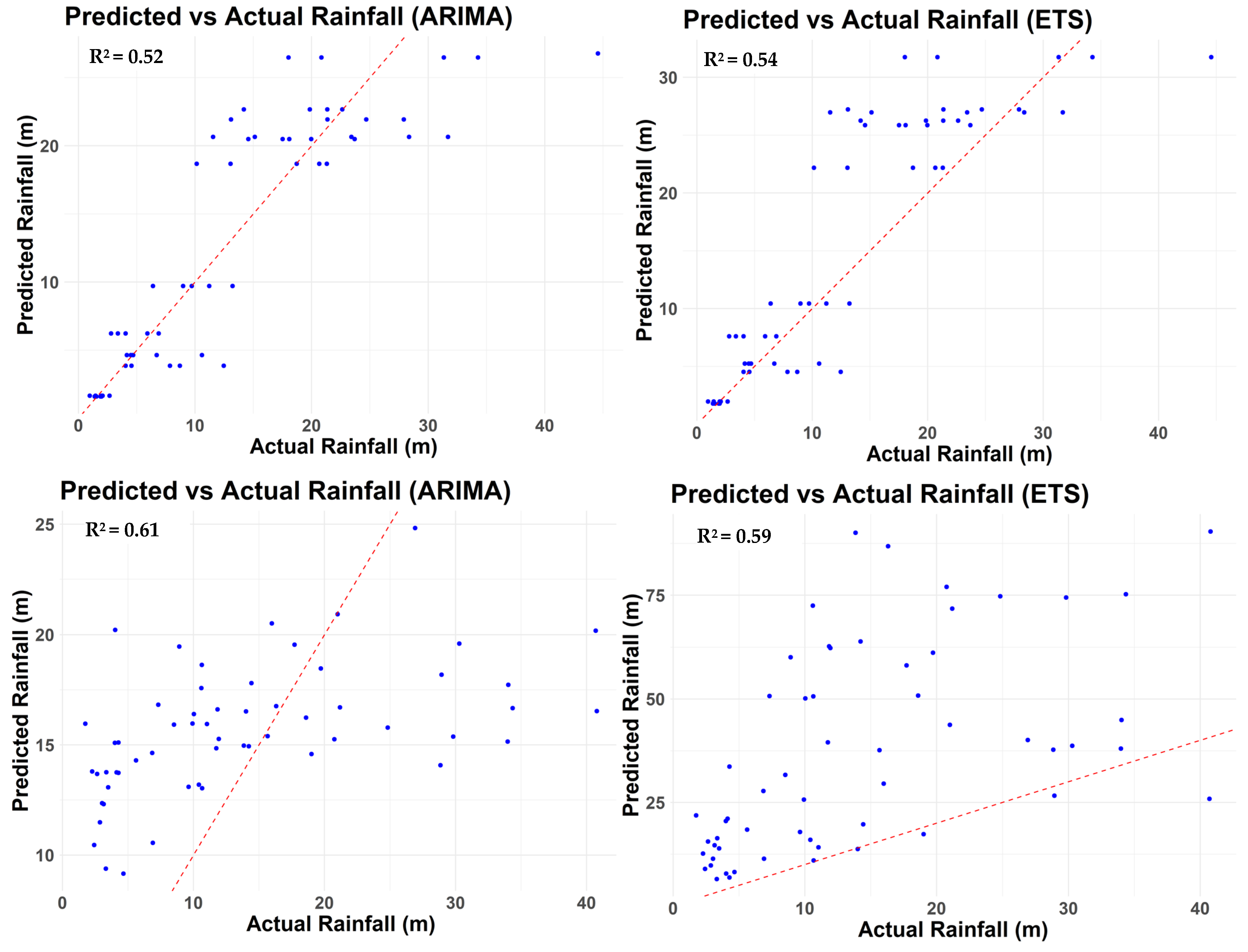
| Sl. No. 1 | Country | DJF | MAM | JJA | SON | ||||||||
| Max | Min | Mean | Max | Min | Mean | Max | Min | Mean | Max | Min | Mean | ||
| CHIRPS data | Saudi Arabia | 509.64 | 0.06 | 254.85 | 110.95 | 0.06 | 55.51 | 79.38 | 0.02 | 39.7 | 184.26 | 0.03 | 92.15 |
| Iraq | 141.08 | 3.6 | 72.34 | 115.4 | 0.31 | 57.86 | 20.39 | 0.01 | 10.2 | 211.5 | 4.89 | 108.2 | |
| Iran | 191.56 | 0.02 | 95.79 | 155.84 | 0.07 | 77.96 | 276.96 | 0.1 | 138.53 | 306.35 | 0.03 | 153.19 | |
| Jordan | 161.28 | 0.74 | 81.01 | 20.88 | 0.13 | 10.51 | 0.38 | 0.01 | 0.2 | 98.08 | 2.51 | 50.3 | |
| Kuwait | 20.49 | 2.74 | 11.62 | 6.18 | 0.49 | 3.34 | 0.73 | 0.01 | 0.37 | 44.66 | 19.26 | 31.96 | |
| Syria | 246.51 | 3.12 | 124.82 | 45.18 | 4.76 | 24.97 | 15.93 | 0.02 | 7.98 | 208.59 | 14.59 | 111.59 | |
| UAE-Qatar- Bahrain | 20.15 | 2.69 | 11.42 | 9.62 | 0.31 | 4.97 | 13.83 | 0.01 | 6.92 | 28.62 | 0.72 | 14.67 | |
| Oman | 15.4 | 0.01 | 7.71 | 55.99 | 0.23 | 28.11 | 64.9 | 0.02 | 32.46 | 14.76 | 0.01 | 7.39 | |
| Yemen | 57.6 | 0.01 | 28.81 | 222.21 | 0.06 | 111.14 | 154.07 | 0.02 | 77.05 | 240.27 | 0.13 | 120.2 | |
| Sl. No. 21 | Country | DJF | MAM | JJA | SON | ||||||||
| Max | Min | Mean | Max | Min | Mean | Max | Min | Mean | Max | Min | Mean | ||
| PERSIANN data | Saudi Arabia | 419.51 | 0.19 | 209.85 | 216.52 | 0.2 | 108.36 | 71.6 | 0.19 | 35.9 | 171.7 | 0.2 | 85.95 |
| Iraq | 130.89 | 0.2 | 65.55 | 104.8 | 12.08 | 58.44 | 0 | 0 | 0 | 157.79 | 2.63 | 80.21 | |
| Iran | 102.91 | 0.19 | 51.55 | 118.28 | 0.22 | 59.25 | 188.14 | 0.19 | 94.17 | 244.28 | 0.47 | 122.38 | |
| Jordan | 107.02 | 0.32 | 53.67 | 32.17 | 10.05 | 21.11 | 0 | 0 | 0 | 73.82 | 1.53 | 37.68 | |
| Kuwait | 12.81 | 0.21 | 6.51 | 40.23 | 10.06 | 25.15 | 0 | 0 | 0 | 36.51 | 11.47 | 23.99 | |
| Syria | 196.68 | 5.3 | 100.99 | 50.98 | 6.26 | 28.62 | 0 | 0 | 0 | 149.3 | 1.9 | 75.6 | |
| UAE-Qatar- Bahrain | 12.53 | 0.23 | 6.38 | 23.22 | 0.39 | 11.81 | 5.84 | 0.2 | 3.02 | 29.64 | 0.22 | 14.93 | |
| Oman | 12.94 | 0.19 | 6.57 | 42.58 | 0.19 | 21.39 | 43.32 | 0.22 | 21.77 | 32.62 | 0.21 | 16.42 | |
| Yemen | 45.65 | 0.2 | 22.93 | 356.54 | 0.26 | 178.4 | 247.75 | 0.2 | 123.98 | 60.48 | 0.2 | 30.34 | |
| Data | Model | Error Matrix | |||||
|---|---|---|---|---|---|---|---|
| ME | RMSE | MAE | MPE | MAPE | ACF1 | ||
| CHIRPS | ARIMA | 0.211 | 0.491 | 0.339 | −5.168 | 2.871 | 0.353 |
| Average | −0.294 | 0.584 | 0.348 | −2.142 | 3.485 | 0.314 | |
| ETS | −0.249 | 0.603 | 0.419 | −2.520 | 3.954 | 0.461 | |
| PERSIANN | ARIMA | −0.237 | 1.214 | 0.977 | −0.833 | 2.918 | 0.440 |
| Average | −0.336 | 1.047 | 0.858 | −1.104 | 2.570 | 0.359 | |
| ETS | −0.435 | 0.984 | 0.807 | −1.374 | 2.420 | 0.304 | |
Disclaimer/Publisher’s Note: The statements, opinions and data contained in all publications are solely those of the individual author(s) and contributor(s) and not of MDPI and/or the editor(s). MDPI and/or the editor(s) disclaim responsibility for any injury to people or property resulting from any ideas, methods, instructions or products referred to in the content. |
© 2025 by the authors. Licensee MDPI, Basel, Switzerland. This article is an open access article distributed under the terms and conditions of the Creative Commons Attribution (CC BY) license (https://creativecommons.org/licenses/by/4.0/).
Share and Cite
Radwan, N.; Halder, B.; Ahmed, M.F.; Refadah, S.S.; Khan, M.Y.A.; Scholz, M.; Sammen, S.S.; Pande, C.B. Seasonal Precipitation and Anomaly Analysis in Middle East Asian Countries Using Google Earth Engine. Water 2025, 17, 1475. https://doi.org/10.3390/w17101475
Radwan N, Halder B, Ahmed MF, Refadah SS, Khan MYA, Scholz M, Sammen SS, Pande CB. Seasonal Precipitation and Anomaly Analysis in Middle East Asian Countries Using Google Earth Engine. Water. 2025; 17(10):1475. https://doi.org/10.3390/w17101475
Chicago/Turabian StyleRadwan, Neyara, Bijay Halder, Minhaz Farid Ahmed, Samyah Salem Refadah, Mohd Yawar Ali Khan, Miklas Scholz, Saad Sh. Sammen, and Chaitanya Baliram Pande. 2025. "Seasonal Precipitation and Anomaly Analysis in Middle East Asian Countries Using Google Earth Engine" Water 17, no. 10: 1475. https://doi.org/10.3390/w17101475
APA StyleRadwan, N., Halder, B., Ahmed, M. F., Refadah, S. S., Khan, M. Y. A., Scholz, M., Sammen, S. S., & Pande, C. B. (2025). Seasonal Precipitation and Anomaly Analysis in Middle East Asian Countries Using Google Earth Engine. Water, 17(10), 1475. https://doi.org/10.3390/w17101475











